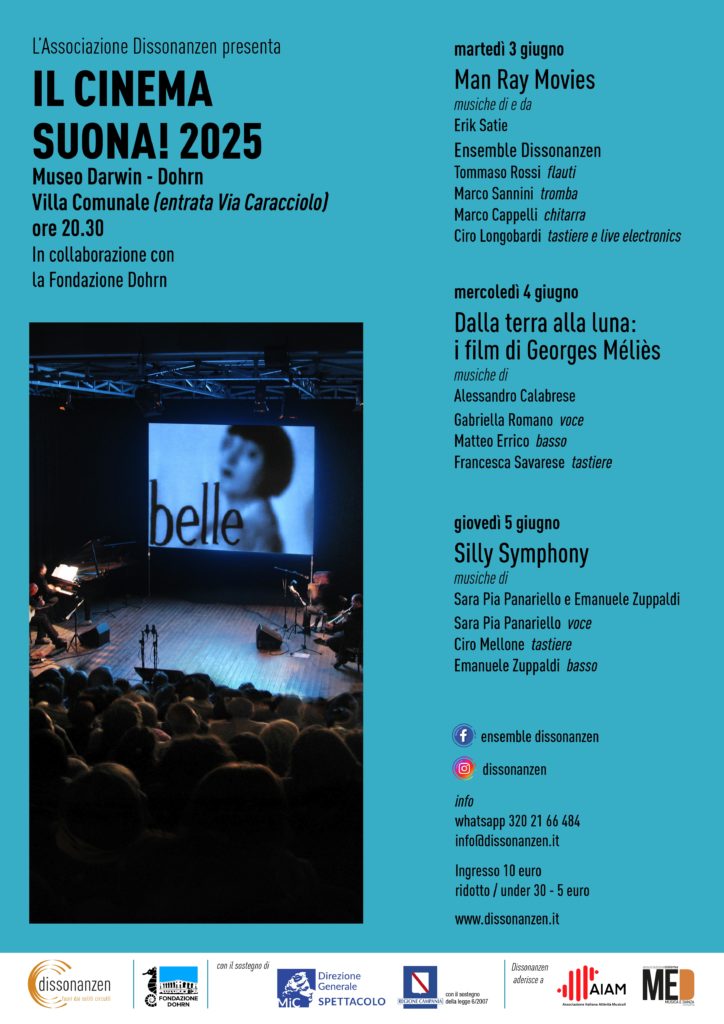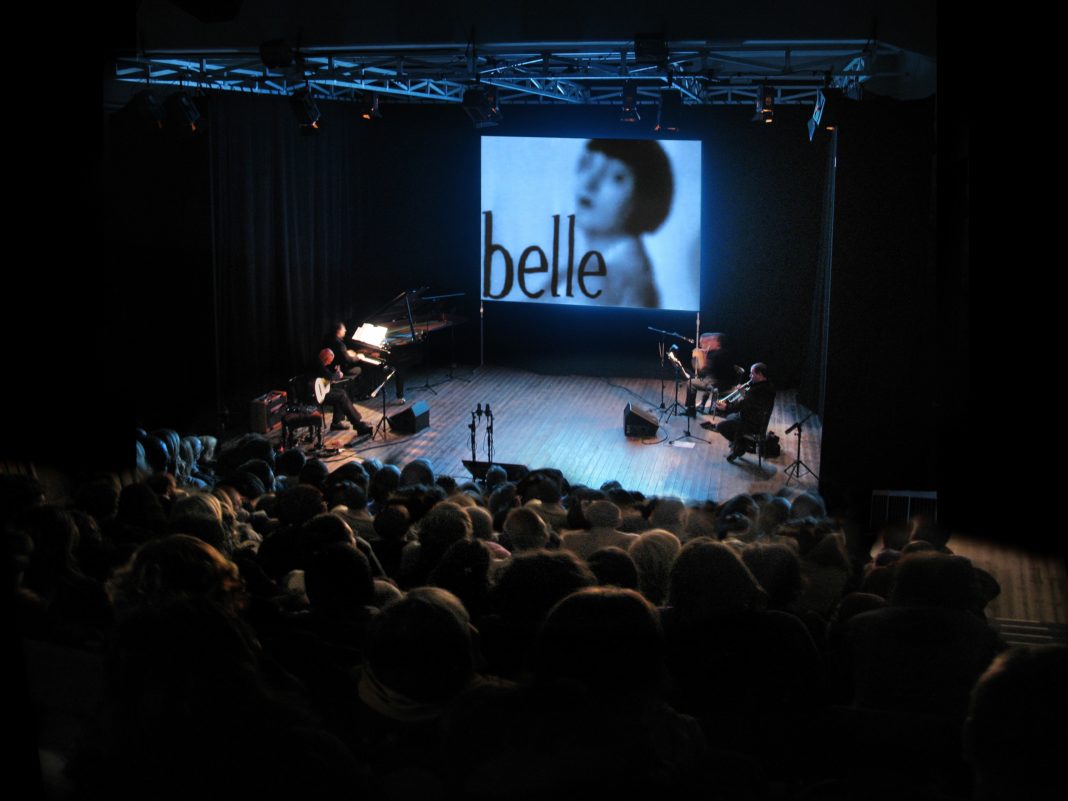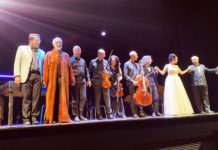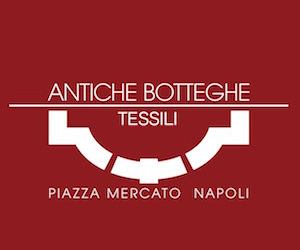Il cinema suona! Torna la rassegna dell’associazione Dissonanzen dal 3 al 5 giugno, sul lungomare di Napoli, in via Caracciolo, alle 20.30, a Napoli, negli spazi del Museo Darwin-Dohrn con musica dal vivo.
Quest’anno, in apertura una vecchia produzione dell’Ensemble Dissonanzen (formato da Marco Sannini alla tromba, Tommaso Rossi ai flauti, Marco Cappelli alla chitarra e Ciro Longobardi al pianoforte digitale esteso): Man Ray Movies (3 giugno ore 20.30), progetto nel quale, attraverso il riutilizzo e la trasformazione di musiche pianistiche di Erik Satie ( di cui quest’anno si celebra il centenario della morte), vengono sonorizzati dal vivo tre film del grande fotografo e artista Man Ray (foto.
Si tratta di Le retour à la raison, del 1923, film che denota il suo carattere provocatorio a partire dal titolo; fu realizzato praticamente in una sola notte con materiali cinematografici in parte già pronti, e fu presentato durante la famosa serata dadaista del “Coeur à barbe”.
Si compone di immagini rayografiche e fotografiche, sequenze isolate, brandelli di pellicola impressionata, organizzate al di fuori di qualsiasi struttura formale e contenutistica: in questo è un perfetto oggetto dadaista, e il suo significato culturale era direttamente proporzionale al suo potere d’urto nell’infrangere, con la sua antistruttura, le convenzioni dell’arte e della cultura dell’epoca.
Segue un cortometraggio del 1928, L’Etoile de Mer, che ci trasporta in un ambiente in cui un certo vincolo narrativo tra le immagini ritrova un senso pur nella dilatazione dei nessi che le collegano.
Lo stesso Man Ray ci racconta la genesi del film: «Una notte dissi al mio amico e poeta Robert Desnos che sarei stato felice di realizzare un film su un suo scritto. Lui era in procinto di partire per un viaggio di due mesi, così io gli promisi che avrei finito il lavoro entro il suo ritorno se lui mi avesse fornito uno spunto prima di partire. Desnos accettò` e, come promesso, la mattina seguente mi portò una composizione poetica scritta durante la notte: si trattava di una storia metà composta da sogno e metà da realtà, che vedeva protagonista una stella di mare che lui teneva in un barattolo accanto al suo letto».
Emak Bakia, del 1926, ci riporta, invece, nel clima di casualità e di anti-struttura de “Le retour à la Raison”, del quale utilizza alcune sequenze.
Ai tre film di Man Ray viene accostata una versione sonorizzata di Anémic Cinéma, cortometraggio del 1926 di Marcel Duchamp, un onirico esperimenti cinematografico.
Il 4 giugno tocca alle opere di Georges Méliès, tra cui Le voyage dans la lune, Eclipse du soleil en plein lune, Le diable noir e altri, con musiche di Alessandro Calabrese. Esecutori saranno Gabriella Romano, voce, Matteo Errico, basso e Francesca Savarese, tastiere. Georges Méliès viene riconosciuto, al fianco dei fratelli Lumière, come il “padre” del cinema.
Il 5 giugno Sara Pia Panariello (voce) e Emanuele Zuppaldi (basso) con Ciro Mellone (tastiere) curano le musiche per la sonorizzazione dal vivo di cortometraggi d’animazione degli anni ’30 appartenenti alle celebri serie Silly Symphony (Walt Disney) e Betty Boop (Fleischer Studios).
Attraverso l’uso di musica originale, effetti sonori e improvvisazioni, si intende offrire una nuova esperienza audiovisiva che unisce la comicità e la poesia dell’animazione classica con la creatività musicale contemporanea.
Gli appuntamenti del 4 e 5 giugno sono in collaborazione con la Scuola di Composizione Jazz del Conservatorio San Pietro a Majella. L’ingresso è di 10 euro (ridotto under 30 a 5 euro). Infoline per prenotazioni: tel. 320 2166484.
Per saperne di più
Learn more
https://www.dissonanzen.it/site/post_dettaglio/1048

The cinema is playing! Back the review of the association Dissonanzen presents, from the 3rd to the 5th June, on the seafront of Naples, in via Caracciolo, at 20.30, in Naples, in the spaces of the Darwin-Dohrn Museum.
This year, opening an old production of the Ensemble Dissonanzen (formed by Marco Sannini on trumpet, Tommaso Rossi on flutes, Marco Cappelli on guitar and Ciro Longobardi on extended digital piano): Man Ray Movies (3 June 20.30), a project in which, through the reuse and transformation of piano music by Erik Satie (whose centenary is celebrated this year), three films by the great photographer and artist Man Ray are soundproofed live.
It is the 1923 film Le retour à la Raison, which denotes its provocative character from the title; it was made practically in a single night with cinematographic materials partly already ready, and was presented during the famous Dadaist evening of “Coeur à barbe”.
It is composed of radiographic and photographic images, isolated sequences, shreds of impressed film, organized outside any formal structure and content: in this is a perfect Dadaist object, and its cultural significance was directly proportional to its shock power in breaking, with its antistructure, the conventions of art and culture of the time.
A short film from 1928, L’Etoile de Mer, takes us into an environment in which a certain narrative link between the images finds a meaning even in the expansion of the links that connect them.
Man Ray himself tells us the genesis of the film: «One night I told my friend and poet Robert Desnos that I would be happy to make a film about his writing. He was about to leave for a two-month trip, so I promised him that I would finish the work by his return if he would give me an idea before leaving. Desnos accepted and, as promised, the next morning he brought me a poetic composition written during the night: it was a story half dream and half reality, which saw protagonist a sea star that he held in a jar by his bed».
Emak Bakia, 1926, brings us back to the atmosphere of randomness and anti-structure of “Le retour à la raison”, of which he uses some sequences.
The three films by Man Ray are accompanied by a sound-proofed version of Marcel Duchamp’s 1926 short film Anémic Cinéma, an oneiric cinematic experiment.
On the4th of June, it’s time for Georges Méliès’ films, including Le voyage dans la lune, Eclipse du soleil en plein lune, Le diable noir and others, with music by Alessandro Calabrese. Gabriella Romano, voice, Matteo Errico, bass and Francesca Savarese, keyboards. Georges Méliès is recognized, alongside the Lumière brothers, as the “father” of cinema.
On the 5th of June Sara Pia Panariello (voice) and Emanuele Zuppaldi (bass) with Ciro Mellone (keyboards) curate the music for the live sound of animated short films from the 30s belonging to the famous series Silly Symphony (Walt Disney) and Betty Boop (Fleischer Studios). Through the use of original music, sound effects and improvisations, it is intended to offer a new audiovisual experience that combines the comedy and poetry of classical animation with contemporary musical creativity.
The events of the 4 th and if the 5 th June are in collaboration with the School of Jazz Composition of the San Pietro a Majella Conservatory. Admission is 10 euro (reduced under 30 to 5 euro). Reservations: tel. 320 2166484.
.










